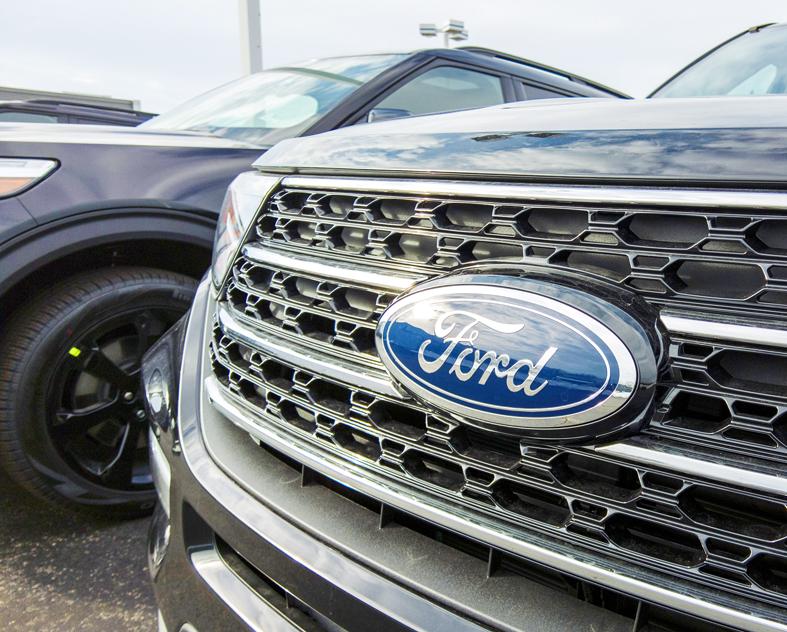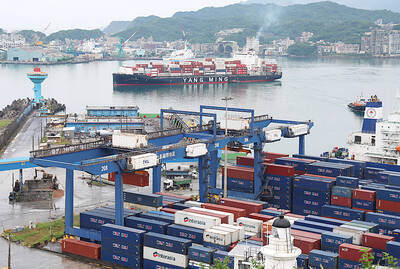Ford Motor Co is to cut production of its most profitable product, the F-150 pickup, next week at two US factories because of a shortage of semiconductors.
This is the second time that Ford has reduced output of its best-selling model due to chip constraints that are roiling the global auto industry and could cost automakers US$61 billion this year.
Ford is in the midst of launching a redesigned version of the truck that is critical to its finances.

Photo: EPA-EFE
The automaker on Thursday said that it would slow its Dearborn, Michigan, assembly plant to one shift from three and its Kansas City, Missouri, factory to two shifts from three.
Ford said that it expects each factory to resume full, three-shift production on Feb. 15.
Late last month, Ford shortened and cut shifts at the two F-150 factories over two days.
The company also cut shifts this week at its Explorer sport utility vehicle (SUV) plant in Chicago and idled a Louisville, Kentucky, SUV factory.
This week, it also shuttered an Ontario factory in part due to a lack of chips.
All three facilities are slated to return to full output on Feb. 8, Ford said.
“We are working closely with suppliers to address potential production constraints tied to the global semiconductor shortage and working to prioritize key vehicle lines for production,” the automaker said in an e-mailed statement.
Production workers at the factories receive about 75 percent of their gross pay from a combination of union benefits and government unemployment assistance while they are laid off.
Ford’s gasoline-powered SUVs and trucks helped haul in an unexpected profit in the fourth quarter of last year, providing a down payment on the US$29 billion that the automaker plans to spend developing electric vehicles (EVs) and autonomous next-generation vehicles.
The manufacturer on Thursday almost doubled its planned spending on EVs to US$22 billion through 2025, a response to the bold initiative outlined by General Motors Co, which aims to go to all zero-emission models by 2035.
Ford also plans to spend US$7 billion on driverless-vehicle technology.
Ford CEO Jim Farley is trying to demonstrate that the automaker’s ambitions are just as aggressive as those of its crosstown rival, while he also works to grow profits with products such as the latest version of its F-150 pickup — the top-selling vehicle in the US for four decades.
“We have no intention to cede ground to others in vehicle segments where Ford is the established leader,” Farley said on a call with analysts. “Our time is now at Ford. We’re not talking about aspirations.”
Ford posted adjusted earnings per share of US$0.34 that easily blew past the US$0.07 loss analysts predicted on average. Adjusted earnings before interest and taxes of US$1.7 billion exceeded the US$347 million average estimate.
Farley said that sales are brisk for the redesigned F-150, the company’s cash cow, with models lasting less than a week on dealer lots.
Executives at the automaker are quick to distinguish GM’s future goals with Ford’s here and now: They pointed to new EVs, such as the plug-in Mustang Mach-E, a battery-powered F-150 pickup due out next year and an early investment in start-up Rivian Automotive Inc, which is to begin production of its own EVs later this year.
“You’re seeing us deliver on our promise to deliver on EVs in mainstream segments where Ford is strong,” chief financial officer John Lawler said on a call with reporters.
Most of Ford’s income still comes from gasoline-powered trucks.

CHIP RACE: Three years of overbroad export controls drove foreign competitors to pursue their own AI chips, and ‘cost US taxpayers billions of dollars,’ Nvidia said China has figured out the US strategy for allowing it to buy Nvidia Corp’s H200s and is rejecting the artificial intelligence (AI) chip in favor of domestically developed semiconductors, White House AI adviser David Sacks said, citing news reports. US President Donald Trump on Monday said that he would allow shipments of Nvidia’s H200 chips to China, part of an administration effort backed by Sacks to challenge Chinese tech champions such as Huawei Technologies Co (華為) by bringing US competition to their home market. On Friday, Sacks signaled that he was uncertain about whether that approach would work. “They’re rejecting our chips,” Sacks

Taiwan’s exports soared 56 percent year-on-year to an all-time high of US$64.05 billion last month, propelled by surging global demand for artificial intelligence (AI), high-performance computing and cloud service infrastructure, the Ministry of Finance said yesterday. Department of Statistics Director-General Beatrice Tsai (蔡美娜) called the figure an unexpected upside surprise, citing a wave of technology orders from overseas customers alongside the usual year-end shopping season for technology products. Growth is likely to remain strong this month, she said, projecting a 40 percent to 45 percent expansion on an annual basis. The outperformance could prompt the Directorate-General of Budget, Accounting and

NATIONAL SECURITY: Intel’s testing of ACM tools despite US government control ‘highlights egregious gaps in US technology protection policies,’ a former official said Chipmaker Intel Corp has tested chipmaking tools this year from a toolmaker with deep roots in China and two overseas units that were targeted by US sanctions, according to two sources with direct knowledge of the matter. Intel, which fended off calls for its CEO’s resignation from US President Donald Trump in August over his alleged ties to China, got the tools from ACM Research Inc, a Fremont, California-based producer of chipmaking equipment. Two of ACM’s units, based in Shanghai and South Korea, were among a number of firms barred last year from receiving US technology over claims they have

BARRIERS: Gudeng’s chairman said it was unlikely that the US could replicate Taiwan’s science parks in Arizona, given its strict immigration policies and cultural differences Gudeng Precision Industrial Co (家登), which supplies wafer pods to the world’s major semiconductor firms, yesterday said it is in no rush to set up production in the US due to high costs. The company supplies its customers through a warehouse in Arizona jointly operated by TSS Holdings Ltd (德鑫控股), a joint holding of Gudeng and 17 Taiwanese firms in the semiconductor supply chain, including specialty plastic compounds producer Nytex Composites Co (耐特) and automated material handling system supplier Symtek Automation Asia Co (迅得). While the company has long been exploring the feasibility of setting up production in the US to address